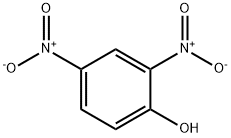AgriculturalChemical; Drug, Mutagen; Reproductive Effector; HumanData; Primary Irritant. 2,4-DNP is used as an intermediatefor making dyes, photochemicals, pest control agents, woodpreservatives, explosives, chemical indicators, photographicdevelopers, and also in chemical synthesis.
light yellow crystal powder
2,4-Dinitrophenol (DNP) can be used:
- As a reactant for catalytic reduction reactions.
- To activate carboxylic acids by converting them into dinitrophenyl (DNP) esters.
- To prepare the corresponding ester via acylation reaction using isobutyric anhydride catalyzed by hafnium triflate.
- As an effective cocatalyst to accelerate the activity and enantioselectivity of primary amine organocatalyst derived from natural primary amino acids for direct asymmetric aldol reaction.
- As an alternative activator to tetrazoles in the reaction of phosphoroamidites with nucleosides.
In manufacture of dyes, other organic
chemicals, wood preservatives, photographic
developer, and explosives
Dinitrophenol is used in the manufacture of dyes, as a wood preservative, and as an indicator and analytical reagent.
ChEBI: 2,4-dinitrophenol is a dinitrophenol having the nitro groups at the 2- and 4-positions. It has a role as an oxidative phosphorylation inhibitor, a bacterial xenobiotic metabolite, an antiseptic drug, an allergen and a geroprotector. It is a conjugate acid of a 2,4-dinitrophenol(1-).
2,4-Dinitrochlorobenzene is hydrolyzed by heating with 6 % aqueous sodium hydroxide at 95 – 100 �℃ for 4 h. The product 2,4-Dinitrophenol is precipitated by addition of acid, filtered off, and washed to remove acid and also a small quantity of the more soluble 2,6-isomer. The yield is 95 %.
Solid yellow crystals. Explosive when dry or with less than 15% water. The primary hazard is from blast of an instantaneous explosion and not flying projectiles and fragments. slightly soluble in water and soluble in ether and solutions of sodium or potassium hydroxide.
Highly flammable. Slightly soluble in water.
2,4-Dinitrophenol may explode if subjected to heat or flame. may explode if allowed to dry out. Forms explosive salts with alkalis and ammonia. Incompatible with heavy metals and their compounds. Also incompatible with strong oxidizing agents, strong bases and reducing agents. Reacts with combustibles.
DUST: POISONOUS IF INHALED OR IF SKIN IS EXPOSED. SOLID: POISONOUS IF SWALLOWED.
2,4-Dinitrophenol is a severely acute toxicant, exhibiting high toxicity in animals by all routes of administration. It can be absorbed through the intact skin. The toxic effects are heavy sweating, nausea, vomiting, collapse, and death. Ingestion of 1 g of solid can be fatal to humans. A 30-minute exposure to its vapors at a concentration of 300 mg/m3 was lethal to dogs (NIOSH 1986). Chronic effects include polyneuropathy, weight loss, cataracts, and dermatitis.
LD50 value, oral (rats): 30 mg/kg.
Combustible. May explode if subjected to heat or flame. POISONOUS GAS IS PRODUCED WHEN HEATED. Vapors are toxic. Can detonate or explode when heated under confinement.
A deadly human poison
by ingestion. An experimental poison by
ingestion, inhalation, intravenous,
intraperitoneal, subcutaneous, and
intramuscular routes. Moderately toxic by
skin contact. Experimental teratogenic and
reproductive effects. Human systemic
effects: body temperature increase, change
in heart rate, coma. A skin irritant. Mutation
data reported. Phytotoxic. A pesticide. An
explosive. Forms explosive salts with alkalies
and ammonia. When heated to
decomposition it emits toxic fumes of NOx.
See also NITRO COMPOUNDS of
AROMATIC HYDROCARBONS.
If this chemical gets into the eyes, remove anycontact lenses at once and irrigate immediately for at least30 min, occasionally lifting upper and lower lids. Seek medical attention immediately. If this chemical contacts theskin, remove contaminated clothing and wash immediatelywith soap and water. Seek medical attention immediately. Ifthis chemical has been inhaled, remove from exposure,begin rescue breathing (using universal precautions, including resuscitation mask) if breathing has stopped and CPR ifheart action has stopped. Transfer promptly to a medicalfacility. When this chemical has been swallowed, get medical attention. Give large quantities of water and inducevomiting. Do not make an unconscious person vomit.Note to physician: Treat for methemoglobinemia.Spectrophotometry may be required for precise determination of levels of methemoglobinemia in urine.
No teratogenic effects have been reported
in limited developmental toxicity studies in
rodents. Decreased fetal body weight and
crown-rump length were noted in rats and
mice after parenteral administration.
2,4-DNP was not genotoxic in most in
vivo and in vitro studies.
An ACGIH threshold limit value (TLV)
has not been established for 2,4-DNP.
The bacterial strain RB1, which is isolated by
enrichment cultivation with 2,4-dinitrophenol, degrades
this phenol into two aliphatic acids. One metabolite
results from the release of the 2-nitro group as nitrile,
with the production of aliphatic nitro compound,
3-nitroadipate. Then, the 3-nitro group is released
from this metabolite as nitrile. The other metabolite is
4,6-dinitrohexanoic acid possessing two nitro groups
from 2,4-dinitrophenol.
(1) Color Code—Red Stripe: FlammabilityHazard: Do not store in the same area as other flammablematerials. (2) Color Code—Blue: Health Hazard/Poison:Store in a secure poison location. Prior to working with thischemical you should be trained on its proper handling andstorage. Dinitrophenol should be kept wet and protectedfrom thermal and mechanical shock. Dinitrophenol must bestored to avoid contact with strong oxidizers (such as chlorine, bromine, and fluorine), metals, and metal compounds,since violent reactions occur. Sources of ignition, such assmoking and open flames, are prohibited where dinitrophenol is handled, used, or stored. Use only nonsparking toolsand equipment, especially when opening and closing containers of dinitrophenol. Wherever dinitrophenol is used,handled, manufactured, or stored, use explosion-proof electrical equipment and fittings.
Dinitrophenol, wetted with not ,15% water, bymass, requires a shipping label of “FLAMMABLE SOLID,POISONOUS/TOXIC MATERIALS.” They fall in DOTHazard Class 4.1 and Packing Group I.
Crystallise it from *benzene, EtOH, EtOH/H2O or H2O acidified with dilute HCl, dry it, then recrystallise it from CCl4. Dry it in an oven and store it in a vacuum desiccator over CaSO4. The benzoate has m 132o (from EtOH). [Beilstein 6 IV 1369.]
Dust forms an explosive mixture withair. Explosion can be caused by heat, friction, or shock.Contact with reducing agents; combustibles, may cause fire and explosions. Forms shock-sensitive explosive salts withammonia, strong bases, and most metals. May accumulatestatic electrical charges, and may cause ignition of itsvapors.
